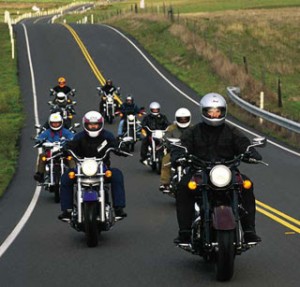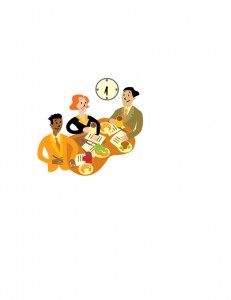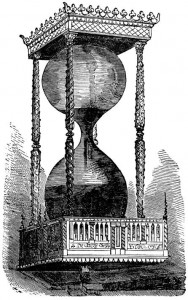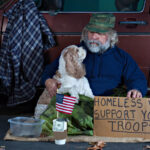The Fearful and Fabulous Motorcycle

Ask any adult what they think about riding a motorcycle and you’re likely to get one of two answers—very cool or totally nuts. For those folks that are dedicated “bikers,” no amount of scary stats on accidents, brain injuries, or deaths will convince them to give up their Harleys or Hondas; others are convinced that even a parked motorcycle is lethal. This is a machine that inspires intense feelings, good, bad, and ugly.Today, more people than ever before are riding motorcycles, some estimates put the number at about
seven million which includes both drivers and passengers. Despite the enduring popular stereotype of a young, brawny dude covered in tattoos and wearing a bandana for a helmet, the fact is that both men and women of all ages are bikers. It’s evident this mode of transportation works for a lot of Americans.
Motorcycle Fears
But there are some good reasons for a cautious approach to motorcycles.
Motorcycle-related deaths increased every single year between 1997 and 2008, a 150% increase. Motorcycle crashes killed 5,290 people in 2008.
Young people are not the only ones dying in motorcycle crashes. In 2008, more than half the people killed in motorcycle crashes were 40 or older, up from 33% in 1998.
While only 9% of riders killed in motorcycle crashes in 2008 were women, almost all passengers (89%) killed in motorcycle crashes were
women.
It is estimated that the economic burden of injuries and deaths from motorcycle related crashes in one year
totaled $12 billion.
A study of 105 motorcyclists hospitalized at a major trauma center determined that
63% of their care was paid for by public funds, with Medicaid accounting for over half of all charges.
Perhaps it’s the last factoids about costs that drives the volatile sentiments against motorcycles but certainly the type of injuries sustained in motorcycle accidents are also frightening. The following information comes from a report issued by the
National Highway Traffic Safety Administration:
Most incapacitating and fatal injuries were sustained when the initial point of impact (IPI) was the front of the motorcycle.
Lower-extremity injuries were the most common injuries sustained
by motorcyclists treated in level I and II trauma centers, followed by upper-extremity and head injuries. While lower-extremity injuries were more frequent, head, chest, and abdominal injuries tended to be more severe.
Injured motorcyclists sustain more leg injuries than any other type of
lower-extremity injury, with bone fractures being more common than soft-tissue injuries.
Some injuries associated primarily with motorcycle accidents include:
Biker’s Arm-a condition in which the nerves in the upper arm are damaged as a result of the biker hitting the ground. Depending on the severity, motorcyclist may lose some or all movement in the affected limb.
Head Injury or Brain Trauma-the most often cited reason for passing universal helmet laws, this type of injury can result in any number of ugly effects including seizures, paralysis, loss of memory and change in brain function. Though some of these symptoms can be temporary others may last a lifetime and cause permanent disability.
Spinal cord injuries-among the most serious of injuries this type of trauma can result in partial or complete paralysis, depending on location of the lesion, that lasts a lifetime.
As to the common causes of motorcycle accidents, in single-vehicle crashes the primary, contributing factor is driver error that results in a slide-out and fall typically from losing control and overbraking or running wide on a curve due to excess speed or undercornering. Alcohol is also a culprit in more than half of all fatal accidents. In motorcycle accidents that involve another vehicle, more than two-thirds of the collisions were caused by a motorist violating the motorcycle’s right of way. It’s as if the bike and rider were
“invisible.” Most riders will tell you their single greatest apprehension on the road is not being “seen” by drivers behind the wheel of a car.
Motorcycle Joys
The list of reasons to be fearful about motorcycles is sobering. Nonetheless, the popularity of motorcycles is growing which prompts the obvious question, what are the joys of riding? In Zen and the Art of Motorcycle Maintenance, the author Robert Persig noted, “You’re completely in contact with it all. You’re in the scene, not just watching it anymore, and the sense of presence is overwhelming.” Here’s what many “in the scene” would say on behalf of motorcycles:
Freedom!-this is the first word you’re likely to hear from a motorcyclist when it comes to why ride; for many riders, the destination is secondary to the journey.
Feeling of the ride-nothing compares to the skill, alertness and dexterity required to navigate a motorcycle; it’s a thrill to be fully engaged and in harmony with the machine.
Fuel savings-bikes can get more than double the mileage of a car on a gallon of gas. With gas prices on the rise, motorcycles have come into the mainstream of American motoring consciousness.
Parking-may not seem like much but what could be more joyful than being able to pull into a parking space where SUV’s dare not go?
Connection-motorcyclists share a bond, they are part of a larger community whose members acknowledge each other on the road.
Individuality-bikers tend to show their personality through how they dress to ride and customize their cycles.
Lower carbon impact-a biker might not say he or she is an environmentalist but the fact remains that motorcycles are an efficient means of transportation
Finally, a lot of motorcyclists might not say it out loud but let’s face it there is something very cool about being a rider. No matter what you do, how you look, or what establishment you walk into, eyes turn in your direction when you carry a helmet under your arm. It is seriously hip.
 Someone please tell me what the Hell’s is wrong with the people that run this country, Republicans and Democrats alike. When the Democrats had control of the House and Senate; they were not able to accomplish much as they were to busy in fighting amongst themselves and letting the people who really needed their help down.
Someone please tell me what the Hell’s is wrong with the people that run this country, Republicans and Democrats alike. When the Democrats had control of the House and Senate; they were not able to accomplish much as they were to busy in fighting amongst themselves and letting the people who really needed their help down.

 He ordered his eldest son, his nephew, and his second wife put to death. He tortured, murdered and imprisoned anyone, including cousins and former friends, known or suspected of being political rivals. He issued an edict on religious freedom for all in his dominions yet dismantled temples and looted their treasuries. He proclaimed himself a follower of the Prince of Peace, yet his path to undisputed power was littered with battles, great and small.
He ordered his eldest son, his nephew, and his second wife put to death. He tortured, murdered and imprisoned anyone, including cousins and former friends, known or suspected of being political rivals. He issued an edict on religious freedom for all in his dominions yet dismantled temples and looted their treasuries. He proclaimed himself a follower of the Prince of Peace, yet his path to undisputed power was littered with battles, great and small. authorities had launched a systematic assault to suppress Christianity. It was a time referred to by members of that community as the “Great Persecution.”
authorities had launched a systematic assault to suppress Christianity. It was a time referred to by members of that community as the “Great Persecution.” Summer and Beach- What to Wear and How to Protect Yourself from the Sun!
Summer and Beach- What to Wear and How to Protect Yourself from the Sun! and oversized sunglasses are in. Also, the color of your sunglasses can vary widely from pink, yellow, and blue to classic grey, black, and brown. Gradient lenses are also popular in 2012. Also, to better protect yourself from relentless sun, bring a brimmed hat or at least a cap. Floppy wide-brimmed hats seem to be all the rage this season. For leisurely strolls along the beach, bring along a cover-up such as chiffon skirt, sarong, or wrap; and for a man, light t-shirt always works well. You can also improve your beach look by playing with your footwear. Instead of plain and boring flip-flops, choose sandals decorated with beads, rhinestones, or appliqués for a true fashion statement.
and oversized sunglasses are in. Also, the color of your sunglasses can vary widely from pink, yellow, and blue to classic grey, black, and brown. Gradient lenses are also popular in 2012. Also, to better protect yourself from relentless sun, bring a brimmed hat or at least a cap. Floppy wide-brimmed hats seem to be all the rage this season. For leisurely strolls along the beach, bring along a cover-up such as chiffon skirt, sarong, or wrap; and for a man, light t-shirt always works well. You can also improve your beach look by playing with your footwear. Instead of plain and boring flip-flops, choose sandals decorated with beads, rhinestones, or appliqués for a true fashion statement. Perhaps Leonardo Da Vinci said it best, “Once you have flown, you will walk the earth with your eyes turned skyward, for there you have been, and there you long to return.” Certainly that lyrical sentiment was true for the two men who celebrate a record setting, 25th anniversary this July.
Perhaps Leonardo Da Vinci said it best, “Once you have flown, you will walk the earth with your eyes turned skyward, for there you have been, and there you long to return.” Certainly that lyrical sentiment was true for the two men who celebrate a record setting, 25th anniversary this July.
 Due to weather conditions, the landing site had been altered from the British Isles to the Ireland coast. Technically, they touched down briefly on the targeted beach but a mechanism that releases the balloon from the capsule failed to work. Soon, they were on a bumpy, bouncing ride across the channel. Rough, contentious seas seeped into the capsule. Though there was some discussion on coaxing the limping conveyance to shore, both men concluded it was wiser to hazard a helicopter rescue from the water after a 60-foot leap off the capsule roof. Despite their soggy touchdown, the trip was an undeniable success.
Due to weather conditions, the landing site had been altered from the British Isles to the Ireland coast. Technically, they touched down briefly on the targeted beach but a mechanism that releases the balloon from the capsule failed to work. Soon, they were on a bumpy, bouncing ride across the channel. Rough, contentious seas seeped into the capsule. Though there was some discussion on coaxing the limping conveyance to shore, both men concluded it was wiser to hazard a helicopter rescue from the water after a 60-foot leap off the capsule roof. Despite their soggy touchdown, the trip was an undeniable success.
 Lovers of the English language might enjoy this. It is yet another example of why people learning English have trouble with the language. Learning the nuances of English makes it a difficult language. (But then, that’s probably true of many languages.)
Lovers of the English language might enjoy this. It is yet another example of why people learning English have trouble with the language. Learning the nuances of English makes it a difficult language. (But then, that’s probably true of many languages.) The 4th of July is probably one of the most well-known and beloved holidays in the United States of America. Everybody looks forward to firing up some barbecue, inviting friends and family to share their meal, watch the fireworks, and enjoy all things American. However, there is considerably more behind this holiday than the usual things, which came to be associated with it. While most people connect the 4th of July with such words as Concord, Lexington, Bunker Hill, and the “British Are Coming,”- there is more to the history of the Independence War. Most people associate the white Protestants as a major force behind the Independence War. However, it was not exactly the case. There were other segments of American population, which provided invaluable input toward the ultimate goal of achieving independence from the British Empire.
The 4th of July is probably one of the most well-known and beloved holidays in the United States of America. Everybody looks forward to firing up some barbecue, inviting friends and family to share their meal, watch the fireworks, and enjoy all things American. However, there is considerably more behind this holiday than the usual things, which came to be associated with it. While most people connect the 4th of July with such words as Concord, Lexington, Bunker Hill, and the “British Are Coming,”- there is more to the history of the Independence War. Most people associate the white Protestants as a major force behind the Independence War. However, it was not exactly the case. There were other segments of American population, which provided invaluable input toward the ultimate goal of achieving independence from the British Empire. Federal government fails when it comes to enforcing United States race classification laws (Changing the majority)
Federal government fails when it comes to enforcing United States race classification laws (Changing the majority) reclassified; they will still be in the majority and therefore need to catch up on their African history by reviewing books like, Dr. Chancellor James Williams an African American sociologist, historian and writer and the author of “The Destruction of Black Civilization” (1971).
reclassified; they will still be in the majority and therefore need to catch up on their African history by reviewing books like, Dr. Chancellor James Williams an African American sociologist, historian and writer and the author of “The Destruction of Black Civilization” (1971). ll, music industry is thriving. The number of albums and songs released each year is growing and new artists appear seemingly on a daily basis. Consequently, musical environment of 2012 is substantially different from that of 1992, at least quantitatively if not qualitatively (in opinions of many people, our two biggest pop stars of today, Lady Gaga and Adele, are somewhat reminiscent of Madonna and Mariah Carey). So, it seems to be good news that all technological innovations led to the positive development of music industry. However, it is not exactly so. While music industry is in good shape, record industry is negatively affected by the ease with which people can access music nowadays.
ll, music industry is thriving. The number of albums and songs released each year is growing and new artists appear seemingly on a daily basis. Consequently, musical environment of 2012 is substantially different from that of 1992, at least quantitatively if not qualitatively (in opinions of many people, our two biggest pop stars of today, Lady Gaga and Adele, are somewhat reminiscent of Madonna and Mariah Carey). So, it seems to be good news that all technological innovations led to the positive development of music industry. However, it is not exactly so. While music industry is in good shape, record industry is negatively affected by the ease with which people can access music nowadays.
 Time and People: How and When We Started Keeping Time
Time and People: How and When We Started Keeping Time
 Ask any adult what they think about riding a motorcycle and you’re likely to get one of two answers—very cool or totally nuts. For those folks that are dedicated “bikers,” no amount of scary stats on accidents, brain injuries, or deaths will convince them to give up their Harleys or Hondas; others are convinced that even a parked motorcycle is lethal. This is a machine that inspires intense feelings, good, bad, and ugly.Today, more people than ever before are riding motorcycles, some estimates put the number at about
Ask any adult what they think about riding a motorcycle and you’re likely to get one of two answers—very cool or totally nuts. For those folks that are dedicated “bikers,” no amount of scary stats on accidents, brain injuries, or deaths will convince them to give up their Harleys or Hondas; others are convinced that even a parked motorcycle is lethal. This is a machine that inspires intense feelings, good, bad, and ugly.Today, more people than ever before are riding motorcycles, some estimates put the number at about  Testosterone, it’s a natural substance with a colorful history and now its synthetic equivalent is a powerful moneymaker for the pharmaceutical industry. The television commercials for testosterone gel are ubiquitous. They go something like this: a middle-aged male, somewhere between ages 46 and 55, can barely drag himself out of bed. He shuffles through his day at the office while the younger men around him appear to skip down the halls. He has no energy for a pick-up game of basketball or handball or tennis. He has no appetite for drinks after work and forget dinner, dancing or sex with the wife. And of course, he’s depressed. Who wouldn’t be? But all it takes is a little testosterone gel and voila, he’ll soon dance the night away, work around the clock, and be a tiger in the bedroom. The Mighty “T” has come out of the illicit steroid trade of sports and into the mainstream of men’s health care.
Testosterone, it’s a natural substance with a colorful history and now its synthetic equivalent is a powerful moneymaker for the pharmaceutical industry. The television commercials for testosterone gel are ubiquitous. They go something like this: a middle-aged male, somewhere between ages 46 and 55, can barely drag himself out of bed. He shuffles through his day at the office while the younger men around him appear to skip down the halls. He has no energy for a pick-up game of basketball or handball or tennis. He has no appetite for drinks after work and forget dinner, dancing or sex with the wife. And of course, he’s depressed. Who wouldn’t be? But all it takes is a little testosterone gel and voila, he’ll soon dance the night away, work around the clock, and be a tiger in the bedroom. The Mighty “T” has come out of the illicit steroid trade of sports and into the mainstream of men’s health care. Let’s not beat around the bush, talking about herpes with a prospective lover isn’t appealing. In fact, it would be easier, and a lot more fun, to admit you’re a vampire; at least you could put in a Twilight DVD and enjoy some popcorn together. But here you are, no popcorn, no movie, no sexy vampire scenes just you introducing a person you find attractive to a secret you find upsetting.
Let’s not beat around the bush, talking about herpes with a prospective lover isn’t appealing. In fact, it would be easier, and a lot more fun, to admit you’re a vampire; at least you could put in a Twilight DVD and enjoy some popcorn together. But here you are, no popcorn, no movie, no sexy vampire scenes just you introducing a person you find attractive to a secret you find upsetting.
 In 1991, the U.S. Congress designated March as an Irish-American heritage month because one of the most popular Irish holidays, St. Patrick’s Day, is celebrated on March 17 every year. The holiday commemorates the death of St. Patrick, the saint patron of Ireland who introduced Christianity to the country in the fifth century. St. Patrick’s Day had been celebrated by Irish people all over the world for more than 1000 years and became very popular in the USA as well. In fact, there are about 40 million people of Irish ancestry living in the USA nowadays, which is almost 8 times the size of the population of the Republic of Ireland of about 4.5 million people.
In 1991, the U.S. Congress designated March as an Irish-American heritage month because one of the most popular Irish holidays, St. Patrick’s Day, is celebrated on March 17 every year. The holiday commemorates the death of St. Patrick, the saint patron of Ireland who introduced Christianity to the country in the fifth century. St. Patrick’s Day had been celebrated by Irish people all over the world for more than 1000 years and became very popular in the USA as well. In fact, there are about 40 million people of Irish ancestry living in the USA nowadays, which is almost 8 times the size of the population of the Republic of Ireland of about 4.5 million people. In the almost forty years since the war in Vietnam ended, the sad image of once proud military men living in alleys and shelters across the country had become familiar along with their grim stories. For most homeless veterans, the path to the street was marked by chronic drug and alcohol abuse often precipitated by PTSD (post traumatic stress disorder) and undiagnosed TBI (traumatic brain injury) that eventually led to loss of jobs, relationships, housing, and dignity. The struggle to assist homeless veterans in the decades between 1965 and 2000 was grim…and then came Iraq, Afghanistan, and Recession.
In the almost forty years since the war in Vietnam ended, the sad image of once proud military men living in alleys and shelters across the country had become familiar along with their grim stories. For most homeless veterans, the path to the street was marked by chronic drug and alcohol abuse often precipitated by PTSD (post traumatic stress disorder) and undiagnosed TBI (traumatic brain injury) that eventually led to loss of jobs, relationships, housing, and dignity. The struggle to assist homeless veterans in the decades between 1965 and 2000 was grim…and then came Iraq, Afghanistan, and Recession.